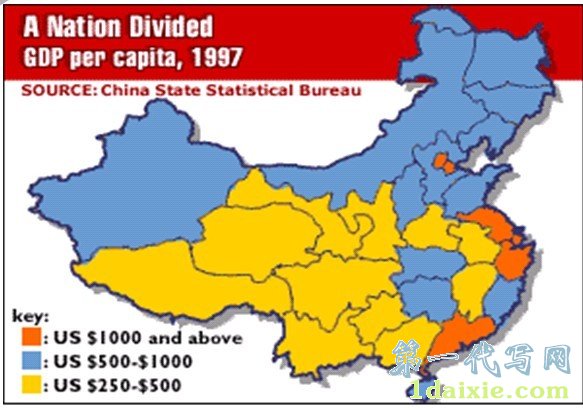留学生市场管理论文‘When China awakes, it will shake the world.’ Attributed to Napoleon Bonaparte
“To get rich is glorious” “When you open the window, flies and mosquitoes come in”
China
Population of around 1.3 billion, about 22% of the global population
Annual growth rate of 10% per annum for the last five years
At current rate China would replace the USA as the world’s largest economy at some point in the next 20 years
Uneven economic development
Coastal regions have been growing at 20%+ per annum
Some interior western provinces have rural peasant economies that have hardly changed in the last 100 years
Will China become the greatest of the world’s economic super powers?
Will this be linked to political liberalisation?
Will China implode as a unified state?
“Study the past if you want to divine the future”
Chinese economy
Chinese domestic companies:
State owned enterprise
Collective owned sector (local)
Indigenous private sector
Foreign invested companies
Foreign-invested joint-venture sector
Foreign invested cooperative enterprises
Wholly foreign owned enterprises
Peasant agriculture
Chinese domestic companies:
State owned enterprises
In 1999 SOEs represented 37% of the number of enterprises in China and controlled 68 percent of total assets.
Consisting largely of central and provincial state-owned enterprises involved in:
Mining, Steel Shipbuilding, Heavy Engineering
Oil, gas and Chemical engineering
Textiles
Tobacco
Finance
Telecoms
Transport
Defence
By 2008 State owned enterprises were:
Around 3% to 5% of total enterprises in China
In control of between 30% to 44% of total assets
On average 13 to 15 times bigger than non state owned companies
Growth in non state sector
“grasping the big, letting go of the small” strategy
Sources: National Economic Census in 2008, Industrial Enterprise Survey
State trading companies
Operate internationally in the import and export of goods, Together with the Bank of China they were involved in:
Currency
Other forms of financial speculation
Examples:
Sinochem Group
China National Metals and Minerals Corp
China Ocean Shipping Company
WTO membership has forced a reduction or elimination of import and export monopolies exercised by state-owned trading companies. Even so, state-trading is still influential for grains, sugar, and fertilizers. A share of each tariff rate quota is reserved for use by China's state-trading companies.
Overall the state sector has been the largest contributor to non-agricultural GDP
Collective owned enterprise
‘Township and village enterprises’(TVE’s)
largely a rural phenomenon
invested in by local governments, individuals and groups
they are a form of local corporatism
Up until 1996 they had been one of the most dynamic sectors of the Chinese economy
TVU’s since the mid 1990’s
Forced to restructure substantially due to increased market integration and competition
TVEs lost their protected position
Changes in the economic environment gradually reduced the benefits of public ownership and increased its costs.
Competition intensified and credit became harder up to 30% have gone out of business
Rural industries today are less tied to their local government and community and have taken on new forms and roles.
Domestically-owned private companies
Small family-run engaged in:
manufacturing
construction
retailing
A significant percentage subcontractors to the joint ventures
“Officer capitalists”
The economic arm of the People’s Liberation Army involved in production of:
Real estate
Toys
Textile machinery
Medical equipment
Foodstuffs such as frozen fish
Defence manufacturing – Poly Technologies
Also had companies involved in:
Hotels
Retailing
International commercial trading
Technology acquisition
International financial transactions
Most of these holdings were spun off into the private sector in the mid 1990’s
Company Profile
Updated: 08-NOV-07
No. 3509 Factory of Chinese People's Liberation Army
International Private company No. 16, Textile Rd., Makou Town, Hanchuan, Hubei, 432301, China ()7128511600, 7128513509 fax, PLA Primary SIC: Broad Woven Fabric Mills, Cotton, Primary NAICS: Broadwoven Fabric Mills Description: Manufacturing: Production of Yarns, Threads and Fabrics
Ads by GoogleDesigner fabrics Get an instant quote on thousands of designer furnishing fabrics
Didn’t operate as a unified command in these economic matters
There are provincial command structures
Created:
Distinct economic interests and ‘officer’ capitalists
Foreign invested companiesForeign and domestic collaborations:
manufacturing such as clothing, electrical goods, glass, cars etc
Services such as hotels, retailing etc.
Companies such as VW, Unilever, Hewlett Packard
Historically 60% of direct investment has come from Hong Kong
Only 15% of land is cultivated
13% of GDP
54% of China population in rural areas (down from 74% in 1990)
Around 100 million floating - migrant workers
Welfare payments linked to place of residence or employment
Shifting balance of power between central and provincial government
Provinces resisting the transfer of tax revenue to the central government
Internal tariff barriers
China’s inevitable collapse
Guangdong, Hong Kong, Fujian, Shanghai
China as a democracy - continual economic development alongside political reform ( as with Taiwan and South Korea)
Political reform the Chinese way
Ref: long-term Outlook for China’s Political reform, Prof Wei-Wei Zhang in The European Union’s Strategic Interests in East Asia, Ed. W. van der Geest, Consortium of European Institute for Asian Studies and Nomissma
Continual economic development with a continued authoritarian political structure (similar to South Korea between 1960-1985)
"Excessive bankruptcies and production cuts will lead to massive unemployment and stir social unrest," Post economic crisis – greater investment through state owned enterprises
Local governments set up 8,000 state owned investment companies in 2009
Volvo bought by Geely with state investment from governments in northeast China and Shanghai
